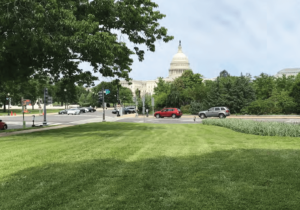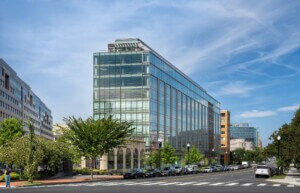Sections of the 7-foot-tall, razor wire-topped security fence erected around the United States Capitol complex in the immediate wake of the destructive January 6 insurrection carried out by supporters of Donald Trump will begin to be dismantled following a determination by the U.S. Capitol Police (USCP) that “there does not exist a known, credible threat against Congress.” As reported by Washington Post, the news was sent to lawmakers and congressional staffers via a security memo on Monday.
Per the memo, portions of the inner-perimeter fencing will be “repositioned” in order to open up access “to the avenues and some of the sidewalks,” which are now encircled by four miles of menacing-looking black metal fencing. The USCP, in collaboration with the Architect of the Capitol (AOC), will begin work on the task this week.
Razor wire will also be removed from still-standing inner-perimeter sections that will remain in place until repair work to damage resulting from the January 6 melee is completed. The memo also elaborated that outer-perimeter fencing will be taken down in the coming days, permitting the regular movement of vehicular traffic on stretches of Independence and Constitutions Avenues that had been blocked off since January 6. Elsewhere, other sections of fencing have already been altered to once again allow regular traffic. Bike racks are also being installed around the Capitol office building according to the memo, presumably for their barrier-like properties and not to accommodate an influx of car-free congressional commuters.
“Finally, the fencing around the Capitol complex is beginning to come down, representing an enormous victory for D.C. residents and the American people,” said Congresswoman Eleanor Holmes Norton, who serves as Washington, D.C.’s non-voting delegate in the House of Representatives, in a statement. “This week, the Architect of the Capitol and the Capitol Police will move the inner fencing around Capitol Square closer to the Capitol, which will allow more pedestrian access to the sidewalks and walkways. Next week, the outer perimeter fencing will be removed. I’ll keep fighting to remove all of the fencing.”
In the memo, acting House Sergeant At Arms Timothy Blodgett stated that the National Guard will continue to have an “increased security posture” in the area but that “based on the current threat posture, it is anticipated that the National Guard will begin to reduce its posture at the Capitol in the coming weeks.”
“The USCP will continue to monitor the threat posture, should a change occur, plans will be reevaluated,” wrote Blodgett.
The prolonged, heightened security presence at the Capitol has generated considerable bipartisan pushback. While the temporary, non-scalable fencing provided reassurance to lawmakers, congressional staffers, and Capitol workers along with D.C. residents in the immediate days following the breach of the Capitol, locals—residents and business owners in the Capitol Hill neighborhood, particularly—have called for it to come down in the weeks following the Presidential Inauguration as it has led to traffic disruptions and given the area an ominous, militaristic air. Many feared that the fencing would become permanent.
On February 11, Norton formally introduced the No Fencing at the United States Capitol Complex Act, legislation prohibiting the fencing in question from gaining permanence. Norton’s move came after Yogananda D. Pittman, acting chief of the USCP, released a January 28 statement that suggested the fencing could become a permanent fixture as part of a larger effort to fortify the complex. (There were particular concerns amongst security officials over March 4, a date of particular significance among right-wing conspiracy theorists although the day came and went without incident.)
“In the year 2021, we should not be relying on security theater based on 19th-century ideas when state-of-the-art options and old-fashioned preparation and cooperation among security forces could have prevented the events of January 6,” wrote Norton in a February 8 statement released before the introduction of her legislation. “My bill banning permanent fencing will help put the needed focus back on security options that don’t wall off the Capitol like a fortress that needs to be protected from the people we represent.”
Per the Post, a security review task force led by retired Lt. Gen. Russel Honoré recommended against permanent fencing in favor of retractable or mobile fencing deployed only during high-security events. Norton, who is now turning her attention to ensuring that full visitor access to the Capitol is restored, has stated that she does not oppose the installation of retractable fencing. She did, however, question the amount of time needed for the inner-perimeter fencing to remain up while repairs at the Capitol continue.
“It seems to me that their time frame could be more rapid, given the inconvenience they’re causing to the public and members of Congress,” Norton said.
Earlier this month, Norton also recently visited with students from Brent Elementary School, a D.C. public school located near the Capitol, to hear their feelings about the fencing.
“I enjoyed my time with these astute future leaders,” Norton said in a statement. “I strongly oppose permanent fencing at the Capitol complex. I continue to press for the complex to be returned to the public, and we are making progress, as evidenced by the recent Task Force 1-6 report, which recommended against permanent above ground fencing at the complex. The fencing around the complex has seriously impacted the surrounding neighborhoods, especially the children who live here, as the Brent third graders showed. These budding advocates did an excellent job in meeting with me and in writing and sharing their experiences. They practiced and used their persuasive writing to push for the fences to come down in their neighborhood.”











